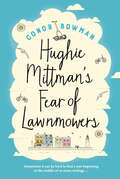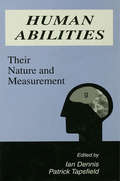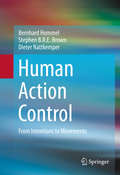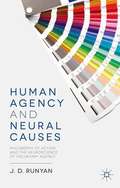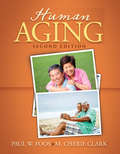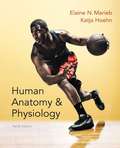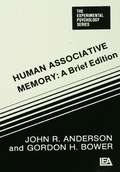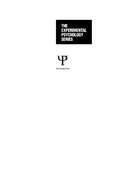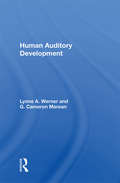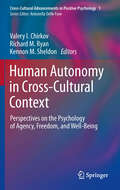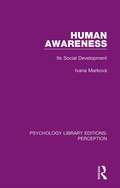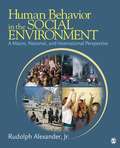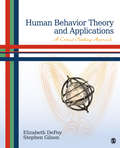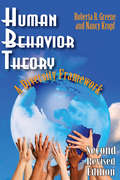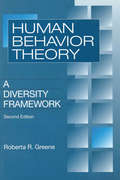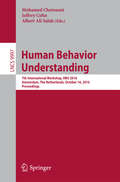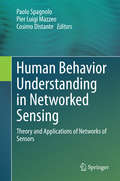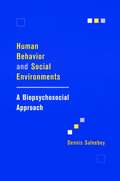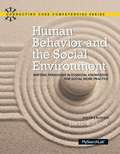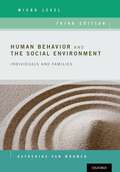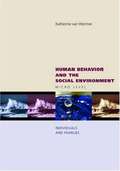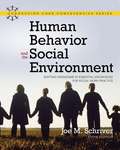- Table View
- List View
Hughie Mittman's Fear of Lawnmowers
by Conor BowmanSometimes it can be hard to find a new beginning in the middle of so many endings...Hughie Mittman is in search of forgiveness. He has just lost his mother and believes it is all his fault. And, with his father more distant than ever, how can Hughie make things right?As he does his best to navigate this unfamiliar version of his life, and overcome his fears - of loss, of change, of lawnmowers - he ignores the questions he really wants answered. Was his father telling the truth when he said Hughie was adopted? And will he really never get to see his mother again?Hughie Mittman's Fear of Lawnmowers is a heart-breaking but uplifting story about grief, the end of childhood, the power of friendship and the acceptance that although there are things we cannot change, the future can still be bright.
Human Abilities: Their Nature and Measurement
by Ian Dennis Patrick TapsfieldThis volume brings together many of the leading researchers on human intelligence and cognition to address issues including definition, measurement, and instructional design. Its publication is a result of the Inaugural Spearman Seminar recently held at the University of Plymouth -- a seminar that is slated to become a regularly scheduled event providing a major international forum for the presentation of work on human abilities. To properly inaugurate this series, scientific experts in this field were asked to reflect on various issues raised but not resolved in Charles Spearman's classic work, The Abilities of Man: Their Nature and Measurement, published in 1927.As a result of this approach, the book offers a unique overview of the way in which the study of human abilities has developed since 1927, and of current positions in the field. It offers exhaustive discussions on:* the nature of cognitive abilities and intelligence -- a review of how the factor analytic approach to abilities which grew out of Spearman's work has developed, thoughts regarding the contribution of a cross-cultural perspective, and an elucidation of some of the conceptual issues which often cloud discussions of ability;* different aspects of the contribution of cognitive psychology to our understanding of abilities -- the relationship between Spearman's g and working memory, links between attention and cognitive style, and the area of spatial abilities;* recent developments in latent variable and item response modeling; and* applied issues -- the argument that little predictive value can be gained in occupational selection from measuring abilities other than Spearman's g, and the question of aptitude treatment interactions in education.
Human Action Control
by Bernhard Hommel Stephen B. R. E. Brown Dieter NattkemperThis textbook provides a comprehensive introduction into the areas of human action planning and action control. It discusses the basic theoretical issues and questions in understanding the planning and control of human goal-directed action. The authors begin by presenting an integrative theoretical framework and the neurobiological foundations of action planning and execution. Subsequent chapters discuss how goals are represented and how they guide action control; how perception and action interact; how simple and complex actions are selected and planned; how multitasking works; and how actions are monitored. Topics of interest include: stimulus-triggered selections, rule-based selections, intentional action selections, and intuitive decision-making. Human Action Control is a must-have resource for advanced undergraduates, graduates, and doctorate students in cognitive psychology and related areas, such as the cognitive neurosciences, and developmental and social psychology.
Human Agency and Neural Causes: Philosophy of Action and the Neuroscience of Voluntary Agency
by J. D. RunyanHuman Agency and Neural Causes provides an analysis of our everyday thought about our conduct, and the neuroscience research concerning voluntary agency. J.D. Runyan argues that our findings through neuroscience are consistent with what would be expected if we are, in fact, voluntary agents.
Human Aging
by Paul W. Foos M. Cherie ClarkThis text offers a readable and friendly presentation of the important methods, findings, and theories of human aging, while actively involving the reader in meaningful exercises and critical thinking. Students are repeatedly challenged to apply information in the text to the older adults in their own lives. Specifically, suggestions for enhancing the lives of their older relatives are offered and encouraged. These include guidelines for discussions they might have regarding social, emotional, and environmental changes as well encouraging intellectual and social interaction. In this Edition: Emphasis on the science of the study of aging and why questions in aging are difficult to answer, how social scientists attempt to handle such difficulties, and the successes and failures social scientists have had thus far in answering those questions. The text also demonstrates how current research findings are now being applied in the real world and/or how they might be applied in the future. Cross-cultural comparisons and ethnic group comparisons are included wherever possible. Each chapter begins with "Senior View," which introduces students to a real person and gives them a chance to hear what older adults think and say about important issues related to the chapter and a chance to compare those opinions to the research findings. Each chapter ends with "Making Choices," emphasizing the important behavioral, emotional, and social choices that students can make now to prolong a healthy, happy life. "Chapter Projects" offer the opportunity for active learning, as students investigate for themselves an issue related to the chapter. Instructors can expand these projects for students who want to learn more, or for independent study. "Focus on Aging" boxes compliment the material in the text, providing additional insight and examples, and encouraging critical thinking. Every chapter includes discussion questions, study questions, chapter exercises, and related online resources.
Human Aging
by Paul W. Foos M. Cherie ClarkThis text offers a readable and friendly presentation of the important methods, findings, and theories of human aging, while actively involving the reader in meaningful exercises and critical thinking. Students are repeatedly challenged to apply information in the text to the older adults in their own lives. Specifically, suggestions for enhancing the lives of their older relatives are offered and encouraged. These include guidelines for discussions they might have regarding social, emotional, and environmental changes as well encouraging intellectual and social interaction. In this Edition: Emphasis on the science of the study of aging and why questions in aging are difficult to answer, how social scientists attempt to handle such difficulties, and the successes and failures social scientists have had thus far in answering those questions. The text also demonstrates how current research findings are now being applied in the real world and/or how they might be applied in the future. Cross-cultural comparisons and ethnic group comparisons are included wherever possible. Each chapter begins with "Senior View," which introduces students to a real person and gives them a chance to hear what older adults think and say about important issues related to the chapter and a chance to compare those opinions to the research findings. Each chapter ends with "Making Choices," emphasizing the important behavioral, emotional, and social choices that students can make now to prolong a healthy, happy life. "Chapter Projects" offer the opportunity for active learning, as students investigate for themselves an issue related to the chapter. Instructors can expand these projects for students who want to learn more, or for independent study. "Focus on Aging" boxes compliment the material in the text, providing additional insight and examples, and encouraging critical thinking. Every chapter includes discussion questions, study questions, chapter exercises, and related online resources.
Human Anatomy and Physiology 10th Edition
by Elaine N. Marieb Katja HoehnHuman Anatomy and Physiology is organized under the following units : 1)Organization of the Body 2)Covering, Support, and Movement of the Body 3)Regulation and Integration of the Body and 4) Maintenance of the Body.
Human Associative Memory
by John R. Anderson G. H. BowerPublished in 1980, part of the Experimental Psychology series. This book proposes and tests a theory about human memory, about how a person encodes, retains, and retrieves information from memory. This edition contains two major parts. First is the historical analysis of associationism and its countertraditions. This still provides the framework that has been used to relate the current research to an important intellectual tradition. This is reproduced without comment from the original book; historical analyses do not need as rapid revision as theoretical analyses. The second part of the book reproduces the major components of the HAM theory.
Human Associative Memory
by John R. Anderson G. H. BowerFirst published in 1973. This book proposes and tests a theory about human memory, about how a person encodes, retains, and retrieves information from memory. The book is especially concerned with memory for sentential materials. We propose a theoretical framework which is adequate for describing comprehension of linguistic materials, for exhibiting the internal representation of propositional materials, for characterizing the interpretative processes which encode this information into memory and make use of it for remembering, for answering questions, recognizing instances of known categories, drawing inferences, and making deductions.
Human Attention in Digital Environments
by Claudia RodaDigital systems, such as phones, computers and PDAs, place continuous demands on our cognitive and perceptual systems. They offer information and interaction opportunities well above our processing abilities, and often interrupt our activity. Appropriate allocation of attention is one of the key factors determining the success of creative activities, learning, collaboration, and many other human pursuits. This book presents research related to human attention in digital environments. Original contributions by leading researchers cover the conceptual framework of research aimed at modelling and supporting human attentional processes, the theoretical and software tools currently available, and various application areas. The authors explore the idea that attention has a key role to play in the design of future technology and discuss how such technology may continue supporting human activity in environments where multiple devices compete for people's limited cognitive resources.
Human Auditory Development
by Lynne A. WernerThis book overviews auditory development in nonhuman species and proposes a common time frame for human and nonhuman auditory development. It attempts to explain the mechanisms accounting for age-related change in several domains of auditory processing.
Human Autonomy in Cross-Cultural Context
by Kennon M. Sheldon Richard Ryan Valery I. ChirkovThis volume presents the reader with a stimulating tapestry of essays exploring the nature of personal autonomy, self-determination, and agency, and their role in human optimal functioning at multiple levels of analysis from personal to societal and cross-cultural. The starting point for these explorations is self-determination theory, an integrated theory of human motivation and healthy development which has been under development for more than three decades (Deci & Ryan, 2000). As the contributions will make clear, psychological autonomy is a concept that forms the bridge between the dependence of human behavior on biological and socio-cultural determinants on the one side, and people's ability to be free, reflective, and transforming agents who can challenge these dependencies, on the other. The authors within this volume share a vision that human autonomy is a fundamental pre-condition for both individuals and groups to thrive, and that without understanding the nature and mechanisms of autonomous agency vital social and human problems cannot be satisfactory addressed. This multidisciplinary team of researchers will collectively explore the nature of personal autonomy, considering its developmental origins, its expression within relationships, its importance within groups and organizational functioning, and its role in promoting to the democratic and economic development of societies. The book is aimed toward developmental, social, personality, and cross-cultural psychologists, towards researchers and practitioners' in the areas of education, health and medicine, social work and, economics, and also towards all interested in creating a more sustainable and just world society through promoting individual freedom and agency. This volume will provide a theoretical and conceptual account of the nature and psychological mechanisms of personal motivational autonomy and human agency; rich multidisciplinary empirical evidence supporting the claims and propositions about the nature of human autonomy and capacities for self-regulation; explanations of how and why different psychological and socio-cultural conditions may play a role in promoting or undermining people's autonomous motivation and well-being, discussions of how the promotion of human autonomy can positively influence environmental protection, democracy promotion and economic prosperity.
Human Awareness: Its Social Development (Psychology Library Editions: Perception #19)
by Ivana MarkováHuman awareness – which forms the basis of all interpersonal relationships – is perhaps the most fascinating phenomenon of biological and socio-cultural evolution. In this innovative book, originally published in 1987, the author introduces the subject of human awareness from the perspective of developmental and social psychology. Using a wide range of psychological and other sources, both classic and more recent from around the world, the book begins with a discussion of awareness as a biological and cultural-historical phenomenon. The reader is then guided through such issues as one’s awareness of others, self-awareness, interpersonal communication, and the search of human beings for recognition by others. The final chapter focuses on human awareness as a relationship between the self and society, with particular emphasis on social stability and change. Human Awareness provided the first comprehensive account of human consciousness in a text that reflected the most exciting recent research in the field at the time and emphasized the need for an integrated and coherent understanding of the various psychological disciplines.
Human Barrier Design and Lifecycle: A Cognitive Ergonomics Approach and Path Forward
by Tom ShephardA common source of failure in a human‑dependent barrier or safety critical task is a designed‑in mismatch error. The mismatch is a cognitive demand that exceeds the human capability to reliably and promptly respond to that demand given the plausible situations at that moment. Demand situations often include incomplete information, increased time pressures, and challenging environments. This book presents innovative solutions to reveal, prevent, and mitigate these and many other cognitive‑type errors in barriers and safety critical tasks. The comprehensive model and methodologies also provide insight into where and to what extent these barriers and task types may be significantly underspecified and the potential consequences.This title presents a new and comprehensive prototype design and lifecycle model specific to human‑dependent barriers and safety critical tasks. Designed to supplement current practice, the model is fully underpinned by cognitive ergonomics and cognitive science. The book also presents a compelling case for why a new global consensus standard specific to human‑dependent barriers is needed. Taking a novel approach, it presents its suggested basis, framing, and content. Both solutions seek to redress deficiencies in global regulations, standards, and practice. The model is guided by industry recommendations and best practice guidance and solutions from globally recognized experts. Its processes are fully explained and supported by examples, analysis, and well‑researched background materials. Real‑life case studies from offshore oil and gas, chemical manufacturing, transmission pipelines, and product storage provide further insight into how overt and latent design errors contributed to barrier degradation and failure and the consequence of those errors.An essential and fascinating read for professionals, Human Barrier Design and Lifecycle: A Cognitive Ergonomics Approach and Path Forward will appeal to those in the fields of human factors, process and technical safety, functional safety, display and safety system design, risk management, facility engineering, and facility operations and maintenance.Chapters 1 and 8 of this book are freely available as downloadable Open Access PDFs at http://www.taylorfrancis.com under a Creative Commons Attribution-Non Commercial-No Derivatives (CC-BYNC-ND) 4.0 International license.
Human Behavior In The Social Environment: A Macro, National, And International Perspective
by Rudolph AlexanderHuman Behavior and the Social Environment: A Macro, National, and International Perspective is a textbook for one of the primary courses in the social work curriculum titled Human Behavior in the Social Environment. The course is offered usually over two semesters, with one focusing on micro issues (how the individual develops in relation to their social enviroment on an individual, family, and group level). The second section of the course typically focuses on macro issues pertaining to how an individual is shaped by their social environment by macro issues including social institutions, community, and the government. This book is intended for the second sequence of the course. It takes a unique approach by incorporating international issues of globalization, which has been an emerging issue in social work. Although it takes this unique perspective, it still covers the basics of macro social work on a national level. Other important areas that are not well represented in competing texts includes coverage of rural issues, the impact of hurricane Katrina on social and community resources, human rights and social justice, the increasing impact of increasing rates of incarceration, and a special section focusing on crisis theory. This book has a number of key selling points. They include: A broad national and international perspective A timely approach that examines issues such as rural communities, the impact of disaster on communities, and increasing incarceration rates Provides special emphasis on human needs and social justice End of chapter discussion questions A student glossary Chapter opening photos An appendix that includes three additonal higher level macro theories which would make the book applicable to Master's level program This book will also contain a number of features that are essential for any book to be adopted in a HBSE course. They include: End of chapter discussion questions Instructor's manual featuring powerpoint slides and a test bank Student study site for recommended reading, chapter summaries, and flash cards
Human Behavior Theory and Applications: A Critical Thinking Approach
by Professor Elizabeth G. DePoy Stephen F. GilsonIn Human Behavior Theory and Applications, authors Elizabeth DePoy and Stephen Gilson use a critical thinking approach to engage students to think in depth about theory and its use in social work practice. With a strong focus on diversity, this book expands its theory coverage to include progressive and the most cutting-edge contemporary thinking. The authors skillfully introduce theory, critically examine each theory, including developmental theories, environmental theories, diversity theories, systems theories, and new and emerging theories, and then apply each theory to social work practice providing a synthesis of classical and contemporary theory for scholarly analysis and application to professional, intellectual, and social action.
Human Behavior Theory: A Diversity Framework (Modern Applications Of Social Work Ser.)
by Nancy KropfAs American society becomes increasingly diverse, social workers must use a variety of human behavior frameworks to understand their clients' culturally complex concerns. This text applies specific human behavior theories to diversity practice. They show how human behavior theory can be employed in interventions in the life problems of diverse client populations at the individual, group, social network, and societal levels.Several groups are examined. They include: minority groups; ethnic groups; women; older adults; members of certain social classes affected by economic and educational (dis)advantage, especially those living in poverty; people with developmental disabilities, people of varying sexual and gender orientations, and religious groups.Case studies that illustrate social work practice in the area are highlighted. The case studies include Social Work Practice within a Diversity Framework; The Social Work Interview; Symbolic Interactionism: Social Work Assessment, Meaning, and Language; Erikson's Eight Stages of Development; Role Theory and Social Work Practice; A Constructionist Approach; Risk, Resilience and Resettlement; Addressing Diverse Family Forms; Small Group Theory; Natural Social Networks; Power Factors in Social Work Practice. This volume will be a fundament resource for practitioners and an essential tool for training.
Human Behavior Theory: A Diversity Framework (Modern Applications Of Social Work Ser.)
by Roberta GreeneIn recent years, advocates for civil rights for minorities, women, and gays and lesbians have become more informed consumers of mental health services. As a result, social work practitioners need to prepare themselves to serve diverse constituencies for who previously held behavioral and cultural assumptions have proven not to be universally applicable. The purpose of Greene's book is to help students and practitioners better understand how social workers have used human behavior theories to more competently address variations in group and community membership within the social worker-client encounter.The book's approach is largely thematic. Most of the chapters explore how particular assumptions of a human behavior theory--psychoanalytic theory, psychodynamic/ego psychology theory, systems theory, behavioral theory, symbolic interaction theory, feminist theory, constructionist theory, small group theory, and an ecological perspective --have been used to answer issues related to cultural diversity. The challenges and limitations of each theory's applications across varying client constituencies are discussed throughout. What sorts of new conceptual issues for the practitioner of family services are raised in work with minority families, for example, or with lesbian families? How does a specific theory help, or not help, in group-specific interventions and evaluations?Intended as a companion volume to the widely adopted human behavior text by Greene and Ephross, Greene's new book fills the need for a wide, synthetic reading of the recent literature.
Human Behavior Understanding
by Albert Ali Salah Jeffrey Cohn Mohamed ChetouaniThis book constitutes the refereed proceedings of the 7th International Workshop on Human Behavior Understanding, HBU 2016, held in Amsterdam, The Netherlands, in October 2016. The 10 full papers were carefully reviewed and selected from 17 initial submissions. They are organized in topical sections named: behavior analysis during play; daily behaviors; gesture and movement analysis; and vision based applications.
Human Behavior Understanding in Networked Sensing
by Cosimo Distante Pier Luigi Mazzeo Paolo SpagnoloThis book provides a broad overview of both the technical challenges in sensor network development, and the real-world applications of distributed sensing. Important aspects of distributed computing in large-scale networked sensor systems are analyzed in the context of human behavior understanding, including topics on systems design tools and techniques. Additionally, the book examines a varied range of applications. Features: contains valuable contributions from an international selection of leading experts in the field; presents a high-level introduction to the aims and motivations underpinning distributed sensing; describes decision-making algorithms in the presence of complex sensor networks; provides a detailed analysis of the design, implementation, and development of a distributed network of homogeneous or heterogeneous sensors; reviews the application of distributed sensing to human behavior understanding and autonomous intelligent vehicles; includes a helpful glossary and a list of acronyms.
Human Behavior and Social Environments: A Biopsychosocial Approach (Foundations of Social Work Knowledge Series)
by Dennis SaleebeyHuman behavior is a subject so vast that it would seem to defy one's ability to comfortably and confidently grasp its varieties, nuances, shapes, and dynamics. But in this wide-ranging and comprehensive survey of the contexts of human behavior, Dennis Saleebey examines the different social science approaches to understanding the way humans react to and are affected by their environment.Using a biopsychosocial perspective, this book demonstrates that there are many paths of knowledge, many methods of inquiry, and many perspectives that can guide one's understanding of human behavior. Resilience (how we cope with trauma) and meaning-making (how we see and make sense of the world around us) provide the conceptual framework of the book. Saleebey examines a number of specific theories relevant to the biopsychosocial approach: part/whole analysis, psychodynamic theory, ecological theory, cognitive theory, and radical/critical theory. Human development is presented as a continuing interaction between individual, family, community, social institutions, and culture. Pedagogical devices to aid the student include chapter overviews, case studies, and meaning-making dialogues at the end of each chapter that pose questions for further thought.
Human Behavior and The Social Environment: Shifting Paradigms in Essential Knowledge for Social Work Practice
by Joe M. SchriverHuman Behavior and the Social Environment, 6/e challenges students to explore both traditional and non-traditional paradigms in examining human behavior and the social environment. Through this examination, readers will better understand individuals, families, groups, organizations, communities and globalization. Students will recognize the range of social systems in which people live and the ways these systems promote or deter people in their health and wellbeing.
Human Behavior and the Social Environment, Micro Level: Individuals and Families
by Katherine Van WormerHuman Behavior and the Social Environment, Micro Level draws on a resilience model to explore the dynamics of human behavior across the life span. Biological, psychological, and spiritual dimensions are covered. Illustrations and vignettes from social work, psychology, literature, philosophy, and current events highlight the turning points in our lives. Critical thinking questions are provided. The result is an essential book that bridges theory and practice in accordance with the 2015 Council on Social Work Education (CSWE) standards.
Human Behavior and the Social Environment: Micro Level: Individuals and Families
by Katherine Van WormerIn a fresh, elegant, and accessible manner, Human Behavior and the Social Environment, Micro Level explores the nuances of the biological, psychological, cultural, and spiritual dimensions of our social lives. Drawing on examples from social work, psychology, literature, philosophy, and current events, it richly illustrates human development and behavior, both normal and abnormal. <P><P>Katherine van Wormer skillfully integrates recent research ranging from brain imaging to international surveys on happiness, lending extraordinary insight into our drives and motivations. The result is a singular textbook that truly bridges theory and practice by revealing the patterns and paradoxes of our behavior in the social context.
Human Behavior and the Social Environment: Shifting Paradigms in Essential Knowledge for Social Work Practice (5th edition)
by Joe M. SchriverThis textbook offers a comparative examination of competing paradigms in the study of human behavior and the social environment. The text focuses at each system level on the need for multiple perspectives that respect the diversity of persons and environments with whom social workers interact.
